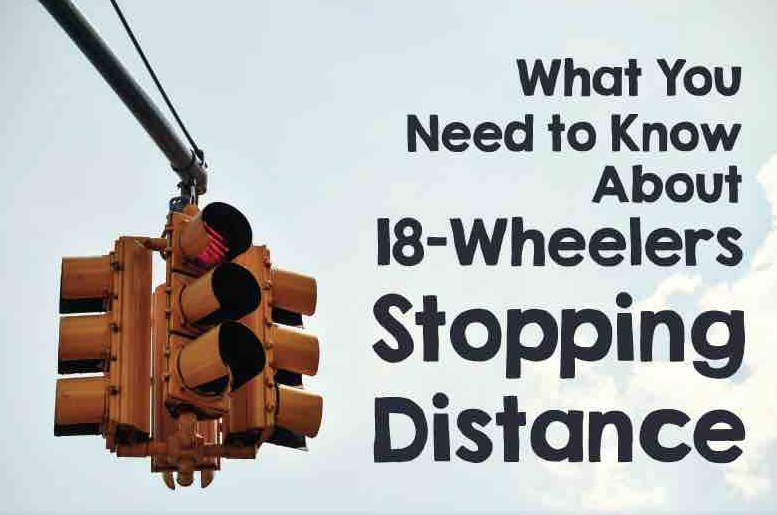
 Request FREE consultation - 1866-758-4529
Request FREE consultation - 1866-758-4529 
Every day on highways across America, big rigs, 18-wheelers, and tractor-trailers share the road with the motoring public. In fact, the trucking industry is vitally important to the American economy. The American Trucking Association projects a banner year for the sales of the most massive class of 18-wheelers for the year 2018.
The only impediment to the stellar growth projected for motor carriers is the shortage of qualified drivers. In short, this year and for years to come, the trucking industry will be growing and putting more and bigger rigs on the highways.
According to the DOT, a tractor-trailer traveling at 65 mph will take 200 yards or 600 feet to come to a stop. The stopping time and distance for a big rig are much higher than those of cars.
Adverse weather conditions and other factors can affect the stopping distance of a big truck.
The total stopping distance for a car going 65 miles an hour is just over 100 yards or about 345 feet.
There are several factors involved in calculating the stopping distance for a particular event. Every driver has a perception lag and also a reaction time before the driver can react actually to start to activate the brakes. Thus, the distinction between how long the vehicle takes to stop after the brakes are engaged and the total stopping distance.
While the accident reconstruction expert can fine-tune the stopping distance for a specific vehicle on a particular roadway, general guidelines are often used for baseline calculations of stopping distance.
Things such as tires, the weight of the vehicle and load, and the coefficient of friction are all used for reconstruction purposes to determine the actual stopping distance in a particular accident.
Commercial trucks use air brakes, while passenger cars have hydraulic brakes. Hydraulic brakes are faster to engage than semi-truck air brakes, with a time lag before they engage.
Also, the weight of the load carried by the big driver is a factor that can make a slight difference in the total stopping distance.
The most important thing that everyone needs to know is that commercial tractor-trailers take longer to stop than passenger cars. An 80,000-pound vehicle even with perfect brakes cannot stop as quickly as your car or pickup truck.
With this in mind, drivers need to be mindful of the need for an extra cushion of safety between their vehicle and a truck behind them. While it is often difficult to keep a truck from tailgating or following that unsafe distance, particularly on busy highways, maintaining a safe distance is critical for your safety.
Because the truck can take 40% longer to stop than your vehicle, you need to ensure that your vehicle is far enough in front of the truck behind you. Driving friendly may involve letting the professional truck driver pass, and that would allow you to control the distance between your vehicle and the big rig.
The devastation from being hit in the rear by an 18-wheeler is not easy to overstate. Many rear-end 18-wheeler accidents injure or kill every person in the vehicle that is struck from the back.
Of course, it should be the professional truck driver who takes extra caution to avoid a rear-end truck accident.
Truckers can avoid rear-ending collisions by:
Trucking companies can reduce the number of rear-end accidents by:
If you or a family member has been rear-ended by a big truck and needs a lawyer- call the specialists in 18-wheeler accident lawsuits today. Speak directly with truck accident attorney Greg Baumgartner -call (281) 893-0760!
Never a Charge For a Truck Crash Injury Consultation!
Related Articles:
Truckers failing to maintain a safe following distance
Stopping Distance is a Major Factor in Big Rig Rear-End Collisions
Braking distance of semi trucks
Why Truck Drivers Must Allow Greater Cushions of Safety